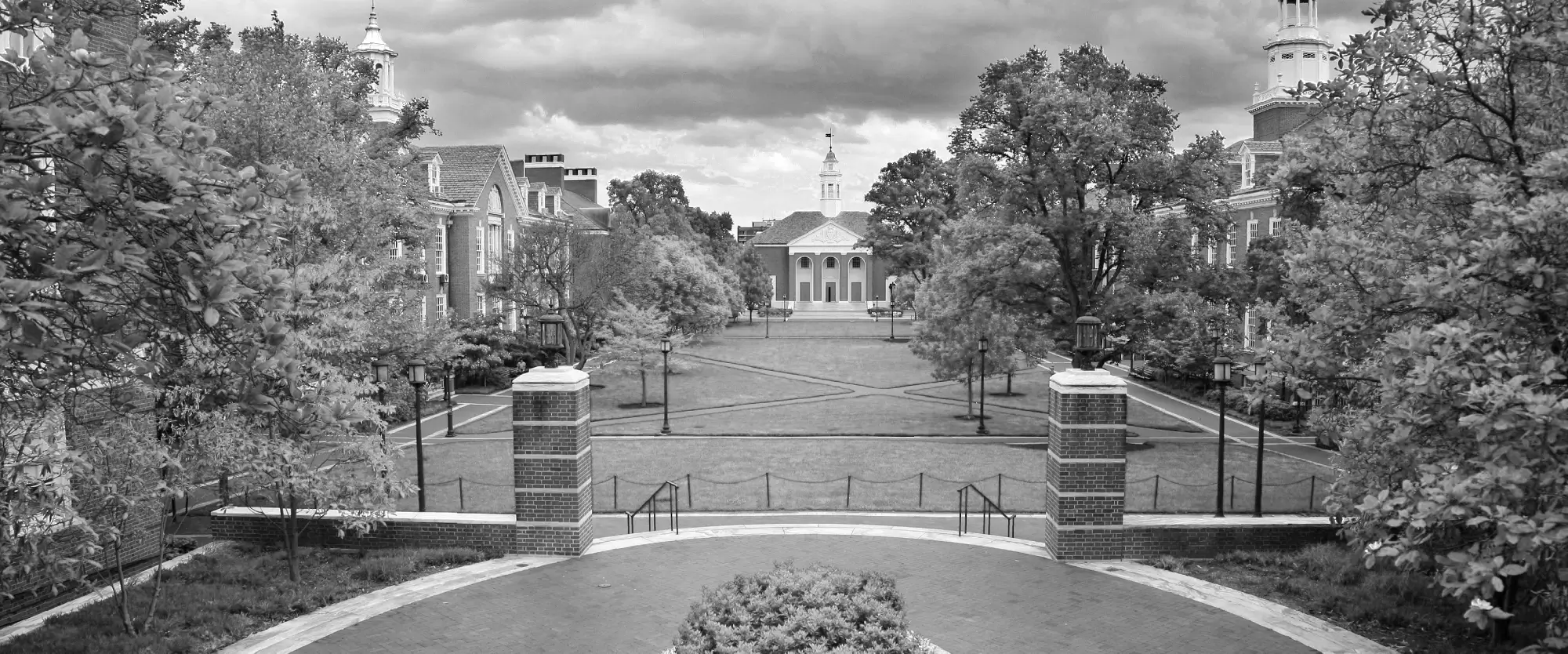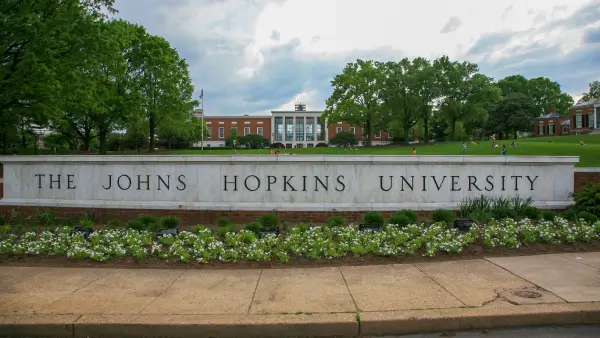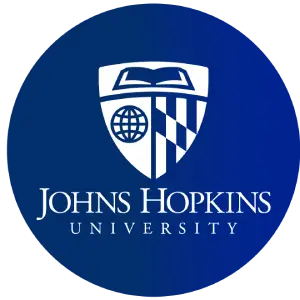
Johns Hopkins University
Johns Hopkins University (JHU), a private research university in Baltimore, Maryland, was founded in 1876 and is widely recognized as the first American university to adopt the European research model, thus pioneering research-driven higher education in the United States.
Named after its first benefactor, entrepreneur and Quaker philanthropist Johns Hopkins, whose $7 million donation was the largest philanthropic gift in U.S. history at the time, the university has since expanded to include graduate campuses in Italy, China, and Washington, D.C. Under its first president, Daniel Coit Gilman, Johns Hopkins emphasized the integration of teaching and research, helping to reshape American academia.
A founding member of the Association of American Universities in 1900, JHU has led all U.S. universities in research and development spending for over 40 years, with expenditures reaching $3.18 billion in 2021. Its main campus in Baltimore houses the undergraduate Krieger School of Arts and Sciences and Whiting School of Engineering, while other campuses across Maryland and beyond host schools of medicine, public health, business, music, and international studies.
Notably, its Blue Jays men’s lacrosse team, a member of the Big Ten Conference, has secured 44 national titles, while the rest of its athletic teams compete in NCAA Division III.
2025 Rankings
by U.S. News & World Report
by QS World University Rankings
by Times Higher Education
Undergraduate Admissions Process Summary
Application Deadlines
Early Decision: November 1
Early Decision 2: January 2
Regular Decision: January 2
Application Portal
Common Application
Coalition Application
Standardized Tests
SAT or ACT required starting Fall 2026 and beyond
Recommendation Letters
Counselor Recommendation: 1
Teacher Evaluation: 2
On Campus Residence for Freshmen
Required
International Students
English Proficiency
TOEFL: minimum score 100
IELTS: minimum score 7.0
Duolingo: Minimum score: 120
Interview
Not required
University Specific Requests
No
Application Fee
$70
-
Cellular and Molecular Biology 12%
-
Computer Science 9%
-
Public Health Studies 9%
-
Neuroscience 8%
-
Biomedical Engineering 8%
-
Chemical Engineering 6%
Popular
Majors
5.7%
Acceptance Rate
$13 billion endowment
4,020 of Faculty Members
83 nations represented

Total Students
-
White 36.5%
-
Asian: 15.5%
-
Hispanic 9.6%
-
Black or African American 7.4%
-
Two or More Races 3.9%
-
American Indian or Alaska Native 0.15%
Campus
Johns Hopkins University began on Howard Street before relocating to its current Homewood campus in northern Baltimore, originally the estate of Charles Carroll, son of the last surviving signer of the Declaration of Independence.
The estate, later owned by the Wyman family, became the park-like setting for the university’s schools of arts and sciences and engineering, with architecture inspired by the Federal-style Homewood House, now a museum.
Most undergraduate programs are based here. The East Baltimore campus, known as Johns Hopkins Medical Institutions (JHMI), houses the Johns Hopkins Hospital, the world-renowned Bloomberg School of Public Health, the top-ranked School of Medicine, and the esteemed School of Nursing.
In downtown Baltimore, the Peabody Institute, the nation’s oldest active music conservatory, and the Carey Business School operate, with the latter moving to the Legg Mason building in Harbor East in 2011. The university also has a major presence in Washington, D.C., including the highly ranked School of Advanced International Studies (SAIS), Advanced Academic Programs, and the Carey Business School, now housed in the former Newseum building.
Additionally, the Applied Physics Laboratory (APL) in Laurel, Maryland, conducts advanced research for NASA, the Department of Defense, and other agencies, serving as a key center for STEM graduate programs and space exploration projects.
Cost of Attendance
California Residents:
-
Tuition $64,730
-
Matriculation Fee (One-time only) $500
-
Living Expenses, Housing (On-Campus) $11,968
-
Living Expenses, Food (On-Campus) $8,182
-
Miscellaneous Personal Expenses $1,514
-
Books, Course Materials, Supplies, and Equipment $1,356
-
Transportation (Average Costs Vary by Home State) $726
-
Total $88,976
At Johns Hopkins, 20% of undergraduates qualified for the Pell Grant
Notable Affiliations
Johns Hopkins University has produced an extraordinary roster of alumni whose achievements span science, politics, academia, international leadership, and the arts. In science and medicine, Hopkins is renowned for producing pioneers like Alfred Blalock, who revolutionized cardiac surgery, and Peter Agre, a Nobel Prize-winning chemist recognized for his discovery of aquaporins, vital for understanding how water moves through cells. In politics and public service, Hopkins alumni have significantly shaped national and global landscapes. Woodrow Wilson, who earned his Ph.D. at Johns Hopkins, went on to become the 28th President of the United States and a Nobel Peace Prize laureate. Michael Bloomberg, another distinguished alumnus, transformed business and governance as the founder of Bloomberg L.P. and a three-term Mayor of New York City.
Hopkins’ influence stretches well beyond U.S. borders. Internationally, leaders like Ellen Johnson Sirleaf, the Nobel Peace Prize-winning former President of Liberia and Africa’s first elected female head of state, studied at Johns Hopkins. Abdullah II, the King of Jordan, also attended graduate programs at Hopkins’ School of Advanced International Studies (SAIS), reinforcing the university’s reputation for educating world leaders. In academia and philosophy, Hopkins nurtured great thinkers such as John Dewey, one of the most influential educational reformers of the 20th century, whose ideas shaped modern democratic education.
Beyond the fields of politics, science, and academia, Johns Hopkins alumni have made notable contributions to arts and culture. Celebrated author and journalist Ta-Nehisi Coates, a MacArthur Fellow, continues to influence conversations on race, identity, and American history through his award-winning writing.

Johns Hopkins is world-renowned for its programs in medicine, public health, international relations, and engineering. It’s especially famous for the Johns Hopkins Hospital and the School of Advanced International Studies (SAIS).
Very competitive! For the Class of 2028, the overall acceptance rate was around 6%–7%. Strong academics, leadership, unique personal qualities, and deep intellectual curiosity are key to standing out.
Yes. The Homewood campus in Baltimore features beautiful brick Georgian architecture, wide quads, and tree-lined walkways. It’s a classic university setting — but with Baltimore’s lively urban culture just beyond the gates.
Yes, he was a real person!
Johns Hopkins (with “Johns” as his first name) was a wealthy 19th-century entrepreneur and abolitionist who donated $7 million — a huge sum at the time — to establish the university and hospital.
There is! Beneath the Homewood campus, a series of old steam tunnels connect various buildings. Though mostly off-limits, stories about adventurous students sneaking through them have become part of campus lore.
Unlike many schools with fierce animals, Johns Hopkins’ mascot is Jay the Blue Jay, a cheerful bright blue bird. He’s a beloved figure at athletic events — and yes, he occasionally wears a lab coat!
Sort of! Seats at the Milton S. Eisenhower Library (known as MSE) become so coveted during finals week that students often jokingly “reserve” their spots with coats, books, and elaborate fortresses of coffee cups.

